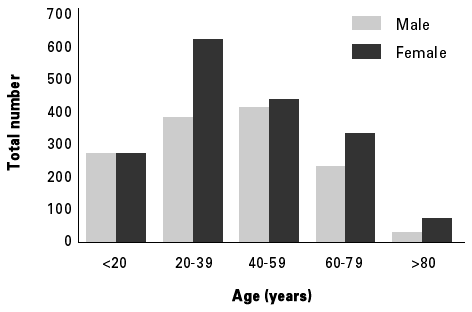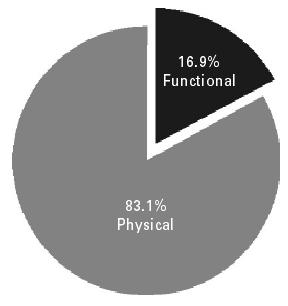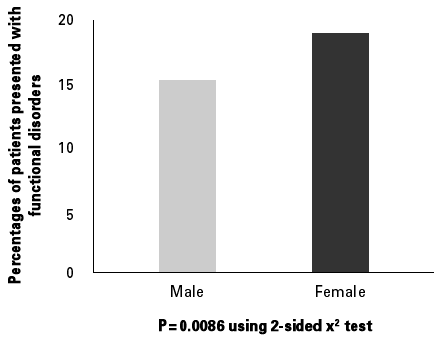
|
September 2003, Volume 25, No. 9
|
Original Article
|
|||||||||||||||||||||||||||||||||||||||||||||||||||||||||||||||||||||||||||||||||||||||||||||||||||||||||||||||||||||||||||||||||||||||||||||||||||||||||||||||||||||||||||||||||||||||||||||||||||||||||||||||||||||||||||||||||||||||||||||||||||||||||||||||||||||||||||||||||||||||||||||||||||||||||||||||||||||||||
The prevalence of functional disorders seen in family practice in Hong Kong*D S L Chan 陳仕鑾,M C S Wong 黃至生,N C L Yuen 阮中鎏 HK Pract 2003;25:413-418 Summary
Objective: To study the prevalence of functional, including psychiatric,
disorders seen in family practice in Hong Kong.
Keywords: Prevalence, functional disorders, family practice 摘要
目的: 研究香港基層醫療功能性疾病(包括精神疾病)的流行率。
Introduction Functional disorders may be defined as conditions having symptoms that are primarily of emotional or psychological origin with no organic cause.1 In the present study we have defined functional disorders as conditions which include anxiety, depression, somatoform, emotional and other psychiatric disorders as stated in our standardised log sheet for all our participants. It has been noted that psychological or psychiatric disorders are among the most frequent causes of morbidities and disabilities worldwide.2 This group of disorders constitutes a significant proportion of visits to all primary care clinics. Epidemiological studies on prevalence of psychological or psychiatric morbidities seen in primary care have been conducted mainly in Western countries while in non-Western countries, little research has been done. The culture and health care systems are different from country to country and the findings from Western countries may not be applicable to Hong Kong. In Hong Kong, most patients if not all, present to their family doctors with symptoms that are related to physical illnesses.3 If the doctor who is pressed for time is not aware, or has little understanding of the presenting behaviour of local patients, the hidden emotional or psychological problems which underlie the presenting symptoms can be easily overlooked. It has been reported that the prevalence of psychological/psychiatric illnesses seen in primary care ranged from 10-20%.4,5 A recent study in Taiwan in 2002 revealed a prevalence rate of 38.2% in their primary care.6 Objective We thought it would be interesting to investigate the prevalence of functional disorders in patients attending primary care clinics in Hong Kong so as to raise the awareness among our family doctors who are providing holistic patient-care in their daily practice in treating the physical, social and psychological aspects of the illnesses of their patients. Method A cross-section of family doctors across Hong Kong, Kowloon and the New Territories were invited to participate in a survey in October 2001. A total of 29 family doctors and 30 clinics participated. (1 doctor participated in 2 clinics). The doctors were requested to record 100 consecutive patients on a standardised log-sheet with the patients' basic characteristics including their sex and age and whether they had physical and/or a functional disorders on any convenient day of the month (Appendix I, II). The 100 patients were recorded as having a functional disorder if they had anxiety, depression, somatoform, emotional or any other psychiatric disorder. Results Thirty sets of recorded log-sheets were returned after the month of October 2001 by the 30 family doctor clinics who participated in the survey. In total, 3047 patients were recorded. There were 1320 males and 1727 females with the majority being in the 20-59 age group (Figure 1). The prevalence of functional disorders (defined as functional, whether their disorders were functional only or together with physical disorders, in our study from hereon) for all studied patients is 16.9% (SD 6.94%, 95% CI: 14.3% to 19.5%) (Figure 2). Prevalence in males was 14.9% compared with 18.6% in females. This difference was tested by a 2-sided X2 test which showed statistical significance (p=0.0086) revealing a female predominance (Figure 3).
This prevalence trend was further supported by the percentages of functional disorders across different age groups in our study (Figure 4). Interestingly, for the 20-39 age group, male patients showed a slightly higher percentage of functional disorders compared with female patients (16.1% versus 15.9%). This apparent deviation may have been an artefact as all the other groups showed a higher female prevalence. Moreover, we have not set out initially to test the prevalence of functional disorders between the two sexes in each age group. We probably need to stratify the data further to answer this question more accurately. This interesting question would certainly warrant another study. We however have a few hypotheses. Firstly, female patients in this age group belong to the reproductive age group. They may have gynaecological and obstetric problems with or without functional elements. They may attend their gynaecologist for their problems rather than their family doctor, who then may be seeing relatively less female patients in this age group. Secondly, males in this age group are also going through a change of role in life by getting married and assuming a father's role; which might create emotional stress and pressure, because their new role is entirely a new responsibility they have never experienced before. There may also be related-alcoholic or other substance abuse problems that may give rise to functional as well as physical disorders. In short, we need to explore these factors further before a conclusion can be reached and this itself may warrant another study. Discussion Functional disorders can be defined as disorders without any structural pathology.7 Other academics might define functional disorders as physical disorders caused or aggravated by psychological factors.8 For the purpose of our study, we have defined functional disorders as conditions which include anxiety, depressive, somatoform, emotional and other psychiatric disorders. Out of 3047 patients recorded in the survey, 16.9% presented with problems having functional elements in their consultations. This is in keeping with previous studies which have shown that emotionally distressed patients are more likely to present to family doctors with physical symptoms than to complain directly of psychological or social problems.9,10 Chinese patients in particular express their emotional problems through somatic complaints.3 It is for these reasons that we decided to present the prevalence of our patients as having functional, together with functional and physical, disorders, which will be a more realistic presentation of our daily consultations with patients. Patients rarely present with a pure functional problem. Studies in a few Western countries showed a prevalence ranging from 10 to 20%4,5 and one study in Taiwan showed a prevalence of 38.2%.6 These studies may have implications concerning increasing awareness among family doctors so that early diagnosis and appropriate management may prevent more serious functional disorders that may follow. This study also may have implications as a morbidity survey in providing information for medical budgeting and the community's need for mental health services such as psychiatric back-up, given the prevalence of functional disorders in the society. Family doctors may also consider upgrading their training in psychiatry and counselling, given the high prevalence of functional disorders seen in their daily practices. The simple sampling method used in selecting our participating family doctors will no doubt lead to possible sampling and confounding bias. There may also be sampling bias among patients as the consecutive 100 recorded patients were again simple sampling without randomisation. One could argue about the possible observational bias among our family doctors with their different educational background, training, experiences, and geographical locations. Also patients come from different cultural, educational and socio-economic backgrounds and may present with different spectrums of diseases. Family doctors with different training backgrounds and experiences may also have different perspectives in diagnosing physical versus functional disorders. Other limitations might include the lack of a gold standard in ascertaining the diagnosis of functional disorders for patients in our study. Perhaps given the appropriate training, appropriate psychiatric backup and resources, it might be feasible to achieve a more accurate community-based study. Another difficulty in verifying the results is that many patients may have been seen only once in the family doctor's clinic. However, our aim here is a general survey among family doctors across the whole of the Hong Kong Special Administrative Region. We hope that the prevalence figures in our survey will be suggestive of the actual situation in Hong Kong, given its comparability with other overseas studies. Conclusion This survey reveals that functional disorders are common among patients presenting to family doctors in Hong Kong. If a more well-defined classification system could be developed for functional disorders, a better comparable and accurate study could be performed for their prevalence in Hong Kong and elsewhere. Family doctors who provide continuous, comprehensive and whole person care for patients and their families within their psychosocial context should always be on the look out for the genuine underlying reasons for consultations by patients so that accurate diagnosis and appropriate treatment can be offered to them. We wish to acknowledge all participating colleagues who spent their valuable time to make this survey possible. Key messages
D S L Chan, MRCGP, FRACGP, FHKCFP, DCH(Lond)
Medical Officer, M C S Wong, BMedSc(Hons), MSc(Hons), MBChB(CUHK), DCH(Irel) Medical Officer, Department of Outpatients, Hong Kong Buddhist Hospital. N C L Yuen, MD(Qld), FRACGP, FHKCFP, FHKAM(Family Medicine) Honorary Clinical Professor, Department of Community and Family Medicine, The Chinese University of Hong Kong. Correspondence to : Dr D S L Chan, Department of Outpatients, Hong Kong Buddhist Hospital, Kowloon, Hong Kong.
References
|
||||||||||||||||||||||||||||||||||||||||||||||||||||||||||||||||||||||||||||||||||||||||||||||||||||||||||||||||||||||||||||||||||||||||||||||||||||||||||||||||||||||||||||||||||||||||||||||||||||||||||||||||||||||||||||||||||||||||||||||||||||||||||||||||||||||||||||||||||||||||||||||||||||||||||||||||||||||||||



